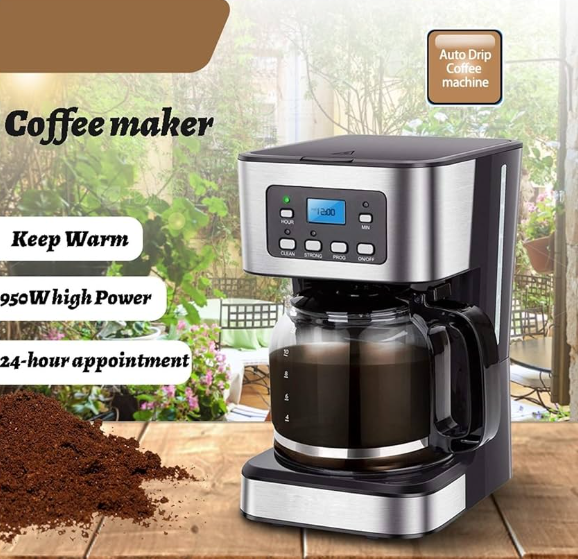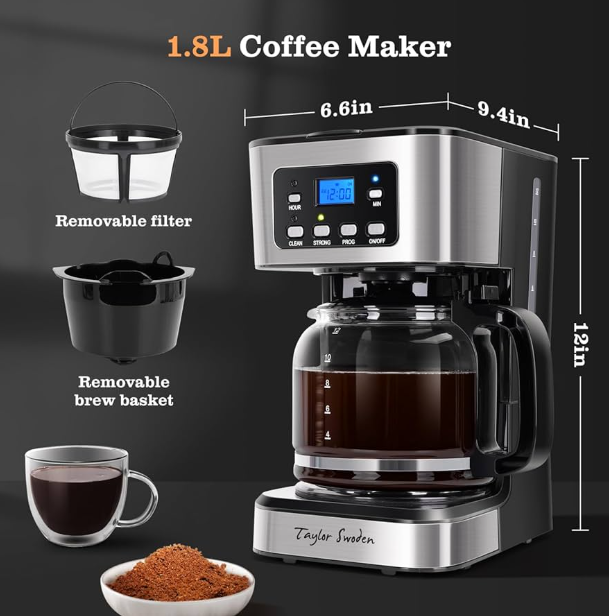Proper coffeemaker maintenance tips are essential for ensuring your coffee machine delivers great-tasting coffee and lasts for years. Regular care prevents issues like stale flavors, clogs, or mechanical failures, whether you own a budget drip brewer or a high-end espresso machine. This guide provides practical, easy-to-follow coffeemaker maintenance tips to keep your machine in top shape, covering cleaning, troubleshooting, and safety. For more brewing tips, visit coffeemakert.com.
Why Coffeemaker Maintenance Matters
Maintaining your coffee machine isn’t just about cleanliness—it directly impacts the quality of your coffee and the longevity of your appliance. Neglecting coffeemaker maintenance can lead to mineral buildup, coffee oil residue, or mold, all of which affect flavor and performance. Regular care also reduces the need for costly repairs or replacements, making it a smart investment of time. Whether you’re using a simple drip coffeemaker or a super-automatic espresso machine, these coffeemaker maintenance tips will help you brew consistently delicious coffee.
Coffeemaker Cleaning: The Foundation of Maintenance
One of the most critical coffeemaker maintenance tips is regular cleaning. Coffeemaker cleaning removes coffee oils, limescale, and debris that accumulate over time, ensuring fresh-tasting coffee and smooth operation. Here’s how to keep your machine spotless:
- Clean removable parts after each use: Wash the carafe, filter basket, and any detachable components (like milk frothers) with warm, soapy water or in the dishwasher if the manual permits. For example, the Black+Decker 5-Cup Coffeemaker’s carafe and filter are dishwasher-safe, simplifying cleanup.
- Wipe the exterior: Use a damp cloth to clean the machine’s exterior, focusing on areas prone to spills, like the brew basket or drip tray. This prevents sticky buildup and keeps your machine looking new.
- Rinse reusable filters: If your machine uses a reusable filter, rinse it thoroughly after each brew to remove coffee grounds and oils. For instance, the Hamilton Beach Scoop’s stainless steel filter is easy to clean under running water.
- Descale regularly: Run a descaling cycle every 1-2 months using a 1:1 mix of white vinegar and water or a manufacturer-recommended descaler. Follow with two water-only cycles to eliminate residual taste. For machines with water filters, like the Philips 3200 LatteGo, replace the filter every 3-6 months to reduce descaling frequency.

Coffeemaker Setup: Start with a Clean Slate
Proper coffeemaker setup lays the groundwork for effective maintenance. When you first unbox your machine, follow these coffeemaker maintenance tips to ensure it’s ready for long-term use:
- Rinse before first use: Run 1-2 water-only cycles to remove manufacturing residues. For example, the Mr. Coffee 12-Cup Easy Measure manual recommends a full water cycle to clean the internal components.
- Check water quality: Use filtered water to minimize limescale buildup. Machines like the Philips 5400 Series include an AquaClean filter, which reduces descaling needs when installed correctly during setup.
- Read the manual: Each model has specific setup instructions. For instance, super-automatic espresso machines may require priming the brew group or setting water hardness levels.
A clean setup ensures your machine starts strong, making future maintenance easier. For more guidance on how to use a coffeemaker, check out coffeemakert.com.
Coffeemaker Troubleshooting: Prevent and Fix Issues
Part of effective coffeemaker maintenance is knowing how to address common problems. These coffeemaker troubleshooting tips can save you time and frustration:
- Slow brewing or weak coffee: This often indicates limescale buildup. Descale the machine and check the grind size—too fine can clog drip machines, while too coarse may under-extract. Use medium-grind coffee for most budget drip models.
- Leaking or spilling: Ensure the water tank isn’t overfilled and the carafe or mug is properly aligned. For single-serve machines like the CHULUX, check that the water tank is securely attached.
- Bitter or off-tasting coffee: Clean the brew basket and carafe to remove old coffee oils. Avoid leaving coffee on the hot plate for too long, as it can burn, especially in models like the Black+Decker 12-Cup.
- Machine won’t start: Check the power cord and ensure the water tank is filled, as some machines, like the Hamilton Beach Scoop, won’t brew without water. If issues persist, consult the manual for warranty details.
Regular troubleshooting checks prevent minor issues from becoming major problems, keeping your machine reliable.
Portable Coffeemaker Maintenance: Compact Care
For those using a portable coffeemaker, like the Philips Senseo or Hamilton Beach Scoop, maintenance is even more critical due to their compact designs. These coffeemaker maintenance tips ensure portability doesn’t compromise performance:
- Clean after travel: Rinse the water tank and filter after each trip to prevent mold, especially if stored in a bag or humid environment.
- Check seals and lids: Ensure the water tank and brew basket seals are intact to prevent leaks, a common issue with portable models.
- Use pods or reusable filters: Pod-based machines like the Senseo require less cleaning, but reusable filters need thorough rinsing to avoid clogs.
Portable coffeemakers are designed for convenience, and proper care ensures they remain reliable on the go.
Coffeemaker Tips for Long-Term Care
Beyond cleaning and troubleshooting, these coffeemaker tips help extend your machine’s lifespan:
- Use the right coffee: Avoid oily beans in super-automatic machines, as they can clog grinders. For drip machines, medium-grind coffee works best to prevent sediment.
- Store properly: Keep your coffeemaker in a dry, cool place to avoid mold or corrosion. For glass carafe models, store the carafe separately to prevent cracks.
- Lubricate moving parts: For espresso machines with brew groups, like the Philips 3200, apply food-safe lubricant monthly to keep components moving smoothly.
- Replace parts as needed: Check manufacturer websites for replacement carafes, filters, or seals. Brands like Black+Decker and Mr. Coffee offer affordable replacements.
- Avoid overuse: Don’t run multiple brew cycles back-to-back without letting the machine cool, as this can strain budget models.
For additional coffee guide insights, visit coffeemakert.com.
Coffeemaker Safety: Protecting Your Machine and Yourself
Coffeemaker safety is a key part of maintenance. Follow these coffeemaker maintenance tips to ensure safe operation:
- Unplug when not in use: This prevents electrical issues and saves energy, especially for budget models without advanced safety features.
- Handle glass carafes carefully: Models like the Mr. Coffee 12-Cup have fragile carafes that can break if mishandled.
- Avoid overfilling: Overfilling the water tank can cause spills or damage internal components, particularly in compact machines.
- Use auto-shutoff features: Many budget coffeemakers, like the Hamilton Beach 12-Cup, include auto-shutoff after 2 hours, reducing fire risks.
Adhering to safety guidelines protects both your machine and your household, ensuring worry-free brewing.

Best Coffeemaker Guide: Maintenance for Top Budget Models
In this best coffeemaker guide, we highlight maintenance tips for popular budget models to illustrate how these coffeemaker maintenance tips apply:
- Black+Decker 5-Cup Coffeemaker (DCM600B): Rinse the reusable filter after each use and descale monthly with vinegar. The dishwasher-safe carafe simplifies cleaning, but check the filter basket for coffee oil buildup.
- Hamilton Beach Scoop Single-Serve: Clean the stainless steel scoop filter after every brew and descale every 1-2 months. Its compact design requires careful storage to avoid water tank leaks.
- Philips Senseo Supreme: For pod-based machines, empty the drip tray daily and run a water cycle weekly to prevent pod residue buildup. Replace water filters as recommended.
How to Brew Coffee in a Coffeemaker: Maintenance Connection
Proper how to brew coffee in a coffeemaker practices tie directly to maintenance. Follow these steps to ensure your brewing habits support machine longevity:
- Fill the water tank with filtered water to reduce limescale.
- Use the correct coffee-to-water ratio (1-2 tablespoons per 6 ounces) to avoid clogging the brew basket.
- Place a clean filter (paper or reusable) in the basket to prevent sediment buildup.
- Start the brew cycle and clean the carafe or mug immediately after to avoid coffee oil stains.
- Turn off the machine after brewing to prevent overheating, especially for models without auto-shutoff.
Consistent brewing habits reduce wear and tear, making maintenance easier and coffee tastier.
Conclusion: Master Coffeemaker Maintenance for Better Coffee
These coffeemaker maintenance tips are your key to enjoying consistently great coffee while extending the life of your machine. From regular coffeemaker cleaning and descaling to proper storage and coffeemaker troubleshooting, a little care goes a long way. Whether you own a budget drip machine or a portable single-serve model, following these tips ensures optimal performance and flavor. For more advice on how to brew coffee in a coffeemaker, visit coffeemakert.com. With the right maintenance routine, your coffeemaker will remain a reliable part of your daily coffee ritual for years to come.